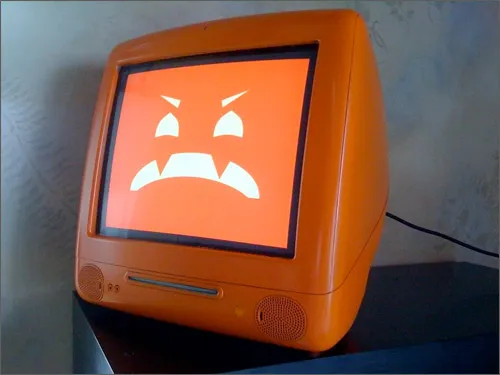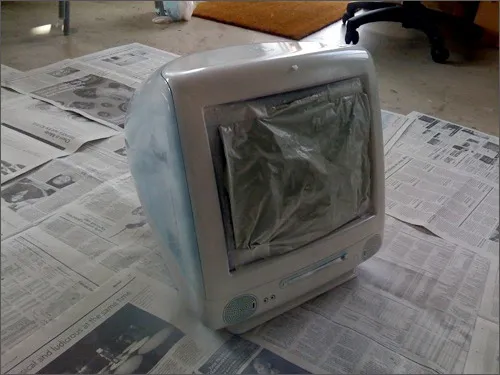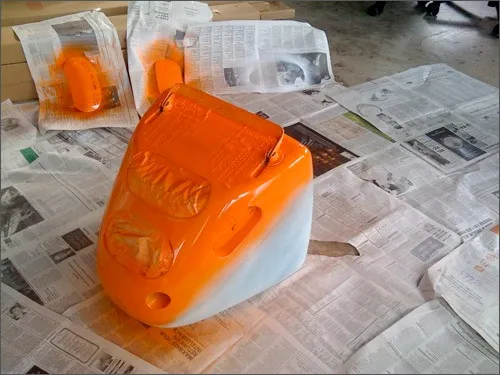I'm not an organized person by nature. I have a terrible memory.
(really, I'm not kidding. My memory (or rather, the gaping hole in my brain where other people have a memory) is legendary. I've forgotten things you people wouldn't believe. I forgot that I'd planned a department-wide trip to a local gallery. I forgot my family's vacation to Hawaii -- it was only when my Mom came in to find out why I wasn't packing that anybody realised I didn't even know we were going on holiday. That day. As in, the rest of the family was IN THE CAR, waiting for me.)
So in order to make it through an ordinary work day, I have to take some extraordinary measures, otherwise everything I'm supposed to get done falls apart. For example, I have to write EVERYTHING down. Anything that Corey doesn't write down doesn't get stored. As those who know me say, "Corey doesn't use his brain for storing things. Besides dinosaurs."
It's true. My brain does feature a remarkable collection of dinosaur-related data. But career opportunities in the dinosaur field are few and far between. And pay like crap.
So anyway, this morning I was in Le Gourmand, picking up my sandwich, when it occurred to me that one of my principal organizing systems was a little idiosyncratic, and might, at least, provide some light entertainment for my three readers (hi JAmes).
And maybe even be useful, if (like me) you occasionally suffer from memory lapses, and (like me) don't find new toys particularly helpful.
My organization system doesn't require web applications, moleskin notebooks, iPhones or even sticky notes.

I call it The 501 Method. Well, that's a lie. I don't call it anything. But the primary tool required IS a pair of Levi 501 jeans, and The 501 Method sounds kind of catchy.
Actually, any article of clothing with a pocket will do -- though it's best if it's an article you wash regularly. The key here is inconveniencing yourself a little bit. Not too much, but a little bit. A little inconvenience is how I keep myself organized.
Basically, I put stuff in my pockets.
I know that doesn't sound too remarkable, and perhaps it isn't, but bear with me.
See, I HATE having my pockets all full of stuff. And key to this whole process is doing things I hate. So I don't organize this stuff. I don't put it in a neat little wallet or something so it won't get munched up. That would reduce the inconvenience, which is counter-productive for The 501 Method.
The stuff, in particular, is pieces of paper. Receipts, or to-do items, or whatever I need to track. Mostly receipts. Whenever I buy something, I ask for the receipt, and I put it in my pocket.
"Okay," I can hear you saying, "You put receipts in your pockets. Fantastic. Great. Earth-shattering."
But see, the receipts in the pocket isn't the clever bit. The CLEVER bit is that when I get home, I take everything in my pockets out of my pockets, and pile it up in front of my iMac.
The iMac isn't really critical to The 501 Method. I know, neither are the 501s, but I have to draw the line somewhere.
So far, the critical bits are:
1. Pocket (for putting things in)
2. Things (for putting in and taking out of pockets)
So you don't really need the iMac so much just yet. What you do need is a place where the receipts will get in the way. Where you can't just keep piling them up day after day.
Remember, inconvenience is what this The 501 Method all about.
So we've gone from stuffing things in our pockets to piling things up in front of an iMac. Onwards.
What happens now is that eventually I get so frustrated with the pile of receipts in front of my iMac that I take action. For myself, I record expenses in a spreadsheet, but the spreadsheet is kind of like the iMac -- interesting, perhaps as a personal detail (hey, Corey knows what a spreadsheet is), but not a key part of the process.
No, our critical bits list for The 501 Method has increased by one:
1. Pocket (for putting things in)
2. Things (for putting in and taking out of pockets)
3. Place (for putting things)
You'll note that the pocket and the place are similar. In fact, we've already wrapped this process and are back at the beginning, so really, the whole process only involves steps 1 and 2.
1. Have a pocket
2. Put things in it.
It's all about inconveniencing yourself so that you end up having to deal with things. Really, I've just inculcated in myself a certain tolerance towards inconvenience, and a caution whenever I find myself doing something that makes things more convenient for myself. Because typically convenience ends up not so convenient. The 501 Method is about embracing inconvenience.
So I'm skeptical of anyone who tries to convince me that a new tool or a new process will make things more convenient for me. The capacity to get things done doesn't necessarily involve things being convenient.
I know The 501 Method is never going to catch on. It's not complicated enough. It doesn't have enough steps. It would be hard to write a book, launch a lecture series or even a PowerPoint presentation about it. Heck, I can't even turn it into a line of clothing without getting sued by venerable Levi Strauss' great-grand-nephews.
Which would be profoundly inconvenient.

 This is Anne Filipowski, one of my favourite people ever.
This is Anne Filipowski, one of my favourite people ever.




 The very nice folks at
The very nice folks at  Some links that have built up over the past while and ought to be shared.
Some links that have built up over the past while and ought to be shared.


 So along with a couple of other FreshBookers I'll be attending next month's
So along with a couple of other FreshBookers I'll be attending next month's 
 And on your right you can see a sight much closer to home, but possibly even more amazing. That is a single exposure you're looking at, presumably a pretty long one, but partway through the exposure the photographer set off a flash inside the cave to illuminate it for the film. Fantastic.
And on your right you can see a sight much closer to home, but possibly even more amazing. That is a single exposure you're looking at, presumably a pretty long one, but partway through the exposure the photographer set off a flash inside the cave to illuminate it for the film. Fantastic.  I also picked up a comic book for Steph that has turned out to beat expectations:
I also picked up a comic book for Steph that has turned out to beat expectations:  A couple of things came together for me today and as per usual, in my head they turned into ideas about making stories about imaginary people even MORE exciting.
A couple of things came together for me today and as per usual, in my head they turned into ideas about making stories about imaginary people even MORE exciting. I've been playtesting a variety of rules for the DINO-PIRATES OF NINJA ISLAND game, and they're starting to settle down into a pretty cohesive whole. The process has been interesting on a lot of levels, but one in particular struck me -- the ability to adjust one's die roll AFTER one knows if that roll was successful.
I've been playtesting a variety of rules for the DINO-PIRATES OF NINJA ISLAND game, and they're starting to settle down into a pretty cohesive whole. The process has been interesting on a lot of levels, but one in particular struck me -- the ability to adjust one's die roll AFTER one knows if that roll was successful.
 At a table during last week's Business of Software conference, I met a fellow whose name escapes me now. Hardly a new occurrence for me, but I do recall the topic we were discussing.
At a table during last week's Business of Software conference, I met a fellow whose name escapes me now. Hardly a new occurrence for me, but I do recall the topic we were discussing.
 Khai Pad Kraphao is pretty much the best lunch around the
Khai Pad Kraphao is pretty much the best lunch around the  We're discussing options for growing our office at FreshBooks, and somebody jokingly said, "Couches for everyone!" -- which got me thinking about the Queen.
We're discussing options for growing our office at FreshBooks, and somebody jokingly said, "Couches for everyone!" -- which got me thinking about the Queen. Fantastic news the other day -- our wildly-hyped product
Fantastic news the other day -- our wildly-hyped product 
 And more than that! I mean, it gets better.
And more than that! I mean, it gets better. The DINO-PIRATES are by no means forgotten, nor have they been left to fend for themselves. We've been working on them all along, and darn soon now, we're going to have some SERIOUS revealage to undertake. These fantastic illustrations are just a backdrop to what's going to put a lot of folks into a great big "Holy Crap!" bit of shock and awe.
The DINO-PIRATES are by no means forgotten, nor have they been left to fend for themselves. We've been working on them all along, and darn soon now, we're going to have some SERIOUS revealage to undertake. These fantastic illustrations are just a backdrop to what's going to put a lot of folks into a great big "Holy Crap!" bit of shock and awe. This principle is evident in the most basic fundamental of Katori Shinto Ryu, the straight head cut called maku-uchi men. As the sword rises up, the front foot draws back until, when the sword reaches it apex over our heads, the front foot reaches the rear foot and we are standing with our feet together. And so as the strike comes down; the sword begins its descent and the front foot slides forward, so that at the moment the sword completes its movement, the foot has returned to its original spot and we are once again standing at the ready.
This principle is evident in the most basic fundamental of Katori Shinto Ryu, the straight head cut called maku-uchi men. As the sword rises up, the front foot draws back until, when the sword reaches it apex over our heads, the front foot reaches the rear foot and we are standing with our feet together. And so as the strike comes down; the sword begins its descent and the front foot slides forward, so that at the moment the sword completes its movement, the foot has returned to its original spot and we are once again standing at the ready. It's not just a case of imposing my will on the world around me. That can get me to MOVE the sword, but in order to operate synchronously with it, I need to move myself in accordance with the laws of physics that govern the movement of a piece of steel. I need to enter into a more complex relationship with the sword, one that accepts and embraces its needs as well as my own.
It's not just a case of imposing my will on the world around me. That can get me to MOVE the sword, but in order to operate synchronously with it, I need to move myself in accordance with the laws of physics that govern the movement of a piece of steel. I need to enter into a more complex relationship with the sword, one that accepts and embraces its needs as well as my own.
 Along the lines of
Along the lines of 
 Reading Mr. Tony Judt's lovely elegy for history in
Reading Mr. Tony Judt's lovely elegy for history in 


 I call it The 501 Method. Well, that's a lie. I don't call it anything. But the primary tool required IS a pair of Levi 501 jeans, and The 501 Method sounds kind of catchy.
I call it The 501 Method. Well, that's a lie. I don't call it anything. But the primary tool required IS a pair of Levi 501 jeans, and The 501 Method sounds kind of catchy.
 I was standing at Spadina and Richmond, the other day, waiting to cross, and watching oncoming traffic, and the light changed and I just stepped out in front of thousands of pounds of fast-moving steel. It occurred to me that I didn't have to make any sort of contact with the drivers of each and every vehicle coming my way in order to be sure that they would stop -- the crossing signal took care of that for me.
I was standing at Spadina and Richmond, the other day, waiting to cross, and watching oncoming traffic, and the light changed and I just stepped out in front of thousands of pounds of fast-moving steel. It occurred to me that I didn't have to make any sort of contact with the drivers of each and every vehicle coming my way in order to be sure that they would stop -- the crossing signal took care of that for me. Crossing signals simplify social interactions.
Crossing signals simplify social interactions. Dave has provided some of the biggest laughs I've had on the Internet since this whole thing began. But it was his
Dave has provided some of the biggest laughs I've had on the Internet since this whole thing began. But it was his  Yes, that is what you might possibly suspect it is. No, I'm not kidding. Yes, I heard about before my (ahem) "departure". No, I wasn't involved. Yes, it's possible that it's worse than you think. No, I didn't get a free copy. Yes, I would have taken one if they'd offered.
Yes, that is what you might possibly suspect it is. No, I'm not kidding. Yes, I heard about before my (ahem) "departure". No, I wasn't involved. Yes, it's possible that it's worse than you think. No, I didn't get a free copy. Yes, I would have taken one if they'd offered. It struck me a few years ago, as I practicing the first kata of omote-tachi -- the foundation of Katori Shinto Ryu -- that the very first thing a student learns is walking. Walking two steps.
It struck me a few years ago, as I practicing the first kata of omote-tachi -- the foundation of Katori Shinto Ryu -- that the very first thing a student learns is walking. Walking two steps.